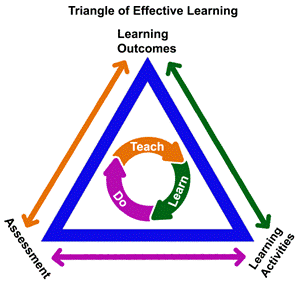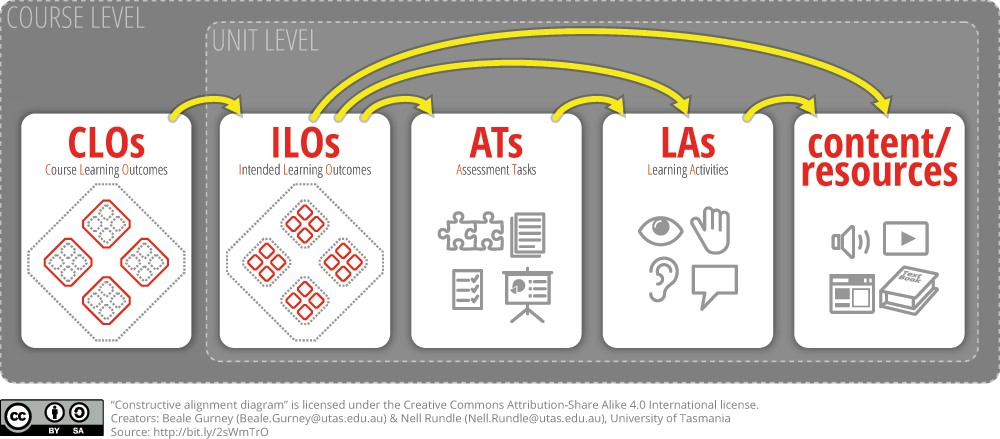Constructive alignment in course design
What is constructive alignment?
Constructive alignment is a foundational element of SCU course and unit design that is embedded in policies and teaching practices. In constructive alignment, learning outcomes for a course (CLOs) or unit of study (ULOs) are effective, clear and purposeful, and they align with the learning activities and assessment tasks. At its heart, constructive alignment is a teaching approach that focuses on what students need to be able to know and do to achieve particular results or goals. Constructive alignment is learning-focused rather than content-focused.
"Constructive Alignment (CA) is a teaching principle that combines constructivism, the idea that learners construct or create meaning out of learning activities and what they learn, and alignment, a curriculum design concept that emphasizes the importance of defining and achieving intended learning outcomes." - de Bie, A., and Brown K.
Creator John Biggs (2014), describes constructive alignment as involving:
- thoughtfully determining intentions of what students should learn (intended learning outcomes) and how students will demonstrate their achievement of these intended learning outcomes (assessment)
- designing teaching and learning activities so that students are optimally engaged in achieving these learning outcomes
- creating assessments that will allow students to demonstrate their attainment of the learning outcomes and allow instructors to discern how well these outcomes have been achieved
- clear communication to students throughout the unit or course about the intended learning outcomes and assessment.
Constructive alignment – at the unit level
When we apply the processes described above, the unit design is said to be 'aligned'. That is, the teaching, learning, and doing aspects are all closely interrelated and support the intended learning outcomes. The Triangle of Effective Learning (Fig. 1) demonstrates this alignment between three core components of a unit: the Learning Outcomes (ULOs), the Assessments and the Learning Activities (content and delivery).
Figure 1: The triangle of effective learning (Benson, 2021)
Watch an introduction to constructive alignment
The following video explains the concept of constructive alignment as it applies to a unit or course design. Note that the key question raised by constructive alignment is not What content will I teach? but, rather, What will students learn to do?
Rubrics and constructive alignment
Don't forget that rubrics are part of the assessment for all SCU units, and play a key role in ensuring constructive alignment. Well-designed rubrics provide a clear illustration of student progress towards learning outcomes. For more information see Rubrics and constructive alignment.
How do the constructive alignment processes fit together?
Constructive alignment broadly covers the design of the course, and its subcomponents, the units.
- Starting with the course level, the skills and knowledge that students require to exit your course are used to devise Course Learning Outcomes (CLOs). Skills and knowledge required at the course level can be determined by benchmarking against other universities, considering the Australian Qualifications Framework (AQF) levels, addressing professional accreditation requirements, and considering the threshold learning outcomes for a discipline.
- At the unit level, Intended Learning Outcomes (ILOs) (known as Unit Learning Outcomes (ULOs) at SCU) capture the skills and knowledge students should learn in the individual unit, and how students will demonstrate achievement. In addition, the ULOs should reflect one (or more) of the CLOs. The assessment tasks must provide authentic opportunities for students to demonstrate their attainment of the ULOs.
- Based on the ULOs and assessment tasks, you create learning activities (the teaching and learning experiences) and curate appropriate content and resources to support both the ULOs and assessment tasks (see Fig. 2).
Figure 2: Course and unit learning outcomes constructively align with assessment tasks, activities, and unit content and resources (UTAS, 2021)
This process of course design is commonly referred to as backwards design because the overall learning outcomes are considered first and the unit content last. This ensures that constructive alignment is achieved by starting with the end goals of the course.
Constructive alignment is not a set approach
It is important to be aware that the application of constructive alignment can vary across universities. There is a context around how a university’s policies, procedures and strategic plan influences the application of constructive alignment. At Southern Cross University, the Curriculum Design and Development Policy and the Curriculum Design and Development Procedures state that constructive alignment mapping forms part of the curriculum design and development process.
Constructive alignment is iterative
Constructive alignment can be an iterative process, as the mapping between the core components often results in refinement in order to ensure better alignment. SCU courses undergo curriculum reviews and a course approval process where constructive alignment may be reevaluated and adapted or modified.
How are constructive alignment (CA) and constructive alignment mapping (CAM) being used at SCU?
Meeting accreditation requirements
Constructive alignment is a tool used at SCU to help meet Tertiary Education Quality and Standard Authority (TEQSA) and the Australia Qualification Framework (AQF) requirements. TEQSA applies constructive alignment in their review and accreditation of higher education courses. Ensuring that all SCU courses follow an ongoing constructive alignment process improves adherence to TEQSA accreditation standards and requirements and maintains the university's standing.
Driving curriculum design
SCU uses a process called constructive alignment mapping (CAM) to drive a quality curriculum and student experience. The Curriculum Design and Development Policy and the Curriculum Design and Development Procedures state that constructive alignment mapping forms part of the curriculum design and development process. You can learn more about this process here: Course Design - Southern Cross University (scu.edu.au).
Enhancing the student experience
Constructive alignment enhances the student experience when used to create a well-designed pathway where students can easily see the connections between the unit learning outcomes (ULOs), the unit content and activities, and the assessment tasks.
Some universities only use constructive alignment as a quality assurance (QA) tool to demonstrate alignment in post-course development. If Southern Cross University only used constructive alignment to meet TEQSA requirements we would lose sight of how the student experience can be improved during the curriculum design process.
In summary, the overall constructive alignment mapping (CAM) process at SCU includes:
- benchmarking course learning outcomes (CLOs) with other universities
- aligning CLOs with:
- AQF levels appropriate to the course
- threshold learning outcomes for disciplinary areas
- professional body requirements
- aligning ULOs to CLOs, appropriate to the level of study (see Schedule A to Definitions (Academic) Policy) and attainment towards achieving these CLOs (i.e. emerging proficiency, increasing proficiency, attained)
- ensuring assessment tasks are designed appropriately so they can determine if the ULOs they map to are attained
- ensuring constructive alignment is continuous throughout unit design and development. This ensures that the intended alignment of ULOs, assessments, content and learning activities is realised.
More about course design and mapping
For more on Course Design and the CAM process at SCU, see Course Design - Southern Cross University (scu.edu.au).
References
de Bie, A., and Brown K. (2021). Forward with FLEXibility: A Teaching and Learning Resource on Accessibility and Inclusion. https://pressbooks.pub/flexforward/
Biggs J. (n.d.). Constructive Alignment. https://www.johnbiggs.com.au/academic/constructive-alignment/
Benson, J. (2021). The triangle of effective learning [graphic]
UTAS (2021). Constructive Alignment. https://www.teaching-learning.utas.edu.au/unit-design/constructive-alignment

